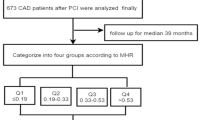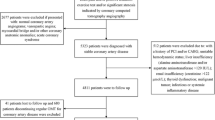Abstract
Purpose
The aim of this study was to investigate the relationship between monocyte count/high density lipoprotein cholesterol (HDL-C) ratio (MHR) and the severity of coronary atherosclerosis, as assessed by the SYNTAX score (SXscore), in patients with stable coronary artery disease (CAD) undergoing coronary angiography.
Materials and methods
A total of 428 patients were included in the study between March 2012 and February 2015. The SXscore was determined with baseline coronary angiography. An SXscore ≥ 23 was regarded as severe CAD by definition, and the patients were divided into two groups: those with low SXscores (< 23) and those with high SXscores (≥ 23).
Results
MHR and C-reactive protein (CRP) were significantly higher in patients with high SXscores (p < 0.001 and p < 0.001, respectively). Left ventricular ejection fraction (LVEF) was lower in the group with high MHR and high SXscores. The cutoff value of MHR that predicted a high SXscore was 24, with a sensitivity of 66 % and a specificity of 65.1 %.
Conclusion
To the best of our knowledge, this is the first study in the literature showing that MHR is significantly associated with SXscores. Our results suggest that MHR can be used as a prognostic marker in patients with stable CAD, since it is an easily available and inexpensive test.
Zusammenfassung
Ziel
Ziel der vorliegenden Studie war es, den Zusammenhang zwischen dem Quotienten aus Monozytenzahl und High-Density-Lipoprotein(HDL)-Cholesterin (MHR) und dem mit dem SYNTAX-Score (SX-Score) erfassten Schweregrad der Koronararteriosklerose bei Patienten mit stabiler koronarer Herzkrankheit (KHK) und erfolgter Koronarangiographie zu untersuchen.
Material und Methoden
Insgesamt 428 Patienten wurden zwischen März 2012 und Februar 2015 in die Studie eingeschlossen. Der SX-Score wurde bei der Ausgangskoronarangiographie ermittelt. Ein SX-Score ≥ 23 galt definitionsgemäß als schwere KHK; demzufolge wurden die Patienten in 2 Gruppen aufgeteilt: jene mit niedrigem SX-Score (< 23) und jene mit hohem SX-Score (≥ 23).
Ergebnisse
MHR und C-reaktives Protein (CRP) waren bei Patienten mit hohem SX-Score signifikant höher (p < 0,001 bzw. p < 0,001) als bei den anderen. Die linksventrikuläre Ejektionsfraktion (LVEF) war in der Gruppe mit hohem MHR und hohem SX-Score niedriger. Der Grenzwert des MHR, der einen hohen SX-Score prognostizierte, lag bei 24, dabei bestand eine Sensitivität von 66 % und eine Spezifität von 65,1 %.
Schlussfolgerung
Soweit den Autoren bekannt ist, handelt es sich hier um die erste Studie in der Literatur, die zeigt, dass der MHR in signifikanter Weise mit dem SX-Score zusammenhängt. Die vorliegenden Ergebnisse weisen darauf hin, dass der MHR als prognostischer Marker bei Patienten mit stabiler KHK eingesetzt werden kann, da er ein leicht verfügbarer und preisgünstiger Test ist.



Similar content being viewed by others
References
Nozawa N, Hibi K, Endo M, Sugano T, Ebina T, Kosuge M et al (2010) Association between circulating monocytes and coronary plaque progression in patients with acute myocardial infarction. Circ J 74(7):1384–1391
Afiune Neto A, Mansur Ade P, Avakian SD, Gomes EP, Ramires JAF (2006) Monocytosis is an independent risk marker for coronary artery disease. Arq Bras Cardiol 86(3):240–244
Olivares R, Ducimetière P, Claude JR (1993) Monocyte count: a risk factor for coronary heart disease? Am J Epidemiol 137(1):49–53
Alderson LM, Endemann G, Lindsey S, Pronczuk A, Hoover RL, Hayes KC (1986) LDL enhances monocyte adhesion to endothelial cells in vitro. Am J Pathol 123(2):334–342
Bath PM, Gladwin A-M, Martin JF (1991) Human monocyte characteristics are altered in hypercholesterolaemia. Atherosclerosis 90(2):175–181
Hafiane A, Genest J (2015) High density lipoproteins: measurement techniques and potential biomarkers of cardiovascular risk. BBA Clinical 3:175–188
Collaboration PS (2007) Blood cholesterol and vascular mortality by age, sex, and blood pressure: a meta-analysis of individual data from 61 prospective studies with 55,000 vascular deaths. Lancet 370(9602):1829–1839
Kanbay M, Solak Y, Unal HU, Kurt YG, Gok M, Cetinkaya H et al (2014) Monocyte count/HDL cholesterol ratio and cardiovascular events in patients with chronic kidney disease. Int Urol Nephrol 46(8):1619–1625
Sianos G, Morel M-A, Kappetein AP, Morice M-C, Colombo A, Dawkins K et al (2005) The SYNTAX Score: an angiographic tool grading the complexity of coronary artery disease. EuroIntervention 1(2):219–227
Caixeta A, Généreux P, Palmerini T, Lansky AJ, Mehran R, Dangas GD et al (2014) Prognostic utility of the SYNTAX score in patients with single versus multivessel disease undergoing percutaneous coronary intervention (from the acute catheterization and urgent intervention triage strategy [ACUITY] trial). Am J Cardiol 113(2):203–210
Capodanno D, Di Salvo ME, Cincotta G, Miano M, Tamburino C, Tamburino C (2009) Usefulness of the SYNTAX score for predicting clinical outcome after percutaneous coronary intervention of unprotected left main coronary artery disease. Circ Cardiovasc Interv 2(4):302–308
Valgimigli M, Serruys PW, Tsuchida K, Vaina S, Morel M-A, van den Brand MJ et al (2007) Cyphering the complexity of coronary artery disease using the syntax score to predict clinical outcome in patients with three-vessel lumen obstruction undergoing percutaneous coronary intervention. Am J Cardiol 99(8):1072–1081
Kundi H, Erel Ö, Balun A, Çiçekçioglu H, Cetin M, Kiziltunç E et al (2015) Association of thiol/disulfide ratio with syntax score in patients with NSTEMI. Scand Cardiovasc J 49(2):95–100
Ross R (1999) Atherosclerosis is an inflammatory disease. Am Heart J 5(138):419–420
Pedicino D, Giglio AF, Galiffa VA, Cialdella P, Trotta F, Graziani F et al (2013) Infections, immunity and atherosclerosis: pathogenic mechanisms and unsolved questions. Int J Cardiol 166(3):572–583
Hansson GK (2005) Inflammation, atherosclerosis, and coronary artery disease. N Engl J Med 352(16):1685–1695
Ridker PM, Hennekens CH, Buring JE, Rifai N (2000) C-reactive protein and other markers of inflammation in the prediction of cardiovascular disease in women. N Engl J Med 342(12):836–843
Taniguchi H, Momiyama Y, Ohmori R, Yonemura A, Yamashita T, Tamai S et al (2005) Associations of plasma C-reactive protein levels with the presence and extent of coronary stenosis in patients with stable coronary artery disease. Atherosclerosis 178(1):173–177
Kurtul A, Murat SN, Yarlioglues M, Duran M, Ergun G, Acikgoz SK et al (2014) Association of Platelet-to-Lymphocyte ratio with severity and complexity of coronary artery disease in patients with acute coronary syndromes. Am J Cardiol 114(7):972–978
Kurtul S, Sarli B, Baktir AO, Demirbas M, Saglam H, Doğan Y et al (2015) Neutrophil to lymphocyte ratio predicts SYNTAX score in patients with non-st segment elevation myocardial infarction. Int Heart J 56(1):18–21
Gratchev A, Sobenin I, Orekhov A, Kzhyshkowska J (2012) Monocytes as a diagnostic marker of cardiovascular diseases. Immunobiology 217(5):476–482
Murphy AJ, Westerterp M, Yvan-Charvet L, Tall AR (2012) Anti-atherogenic mechanisms of high density lipoprotein: effects on myeloid cells. Biochim Biophys Acta 1821(3):513–521
Ansell BJ, Navab M, Hama S, Kamranpour N, Fonarow G, Hough G et al (2003) Inflammatory/antiinflammatory properties of high-density lipoprotein distinguish patients from control subjects better than high-density lipoprotein cholesterol levels and are favorably affected by simvastatin treatment. Circulation 108(22):2751–2756
Navab M, Reddy ST, Van Lenten BJ, Buga GM, Hough G, Wagner AC et al (2012) High-density lipoprotein and 4F peptide reduce systemic inflammation by modulating intestinal oxidized lipid metabolism novel hypotheses and review of literature. Arterioscler Thromb Vasc Biol 32(11):2553–2560
Breton CV, Yin F, Wang X, Avol E, Gilliland FD, Araujo JA (2014) HDL anti-oxidant function associates with LDL level in young adults. Atherosclerosis 232(1):165–170
Canpolat U, Aytemir K, Yorgun H, Sahiner L, Kaya EB, Cay S et al (2015) The role of preprocedural monocyte-to-high-density lipoprotein ratio in prediction of atrial fibrillation recurrence after cryoballoon-based catheter ablation. Europace. doi:10.1093/europace/euu291
Canpolat U, Çetin EH, Cetin S, Aydin S, Akboga MK, Yayla C et al (2015) Association of monocyte-to-HDL cholesterol ratio with slow coronary flow is linked to systemic inflammation. Clin Appl Thromb Hemost. doi:10.1177/1076029615594002
Kundi H, Gok M, Kiziltunc E, Cetin M, Cicekcioglu H, Cetin ZG et al (2015) Relationship between monocyte to HDL-C ratio and the severity of isolated coronary artery ectasia. Am J Cardiol 116(11):1685–1689
Author information
Authors and Affiliations
Corresponding author
Ethics declarations
Conflict of interest
H. Kundi, E. Kiziltunc, M. Cetin, H. Cicekcioglu, Z. G. Cetin, G. Cicek, and E. Ornek state that there are no conflicts of interest.
All studies on humans described in the present manuscript were carried out with the approval of the responsible ethics committee and in accordance with national law and the Helsinki Declaration of 1975 (in its current, revised form). Informed consent was obtained from all patients included in studies.
Rights and permissions
About this article
Cite this article
Kundi, H., Kiziltunc, E., Cetin, M. et al. Association of monocyte/HDL-C ratio with SYNTAX scores in patients with stable coronary artery disease. Herz 41, 523–529 (2016). https://doi.org/10.1007/s00059-015-4393-1
Received:
Revised:
Accepted:
Published:
Issue Date:
DOI: https://doi.org/10.1007/s00059-015-4393-1




